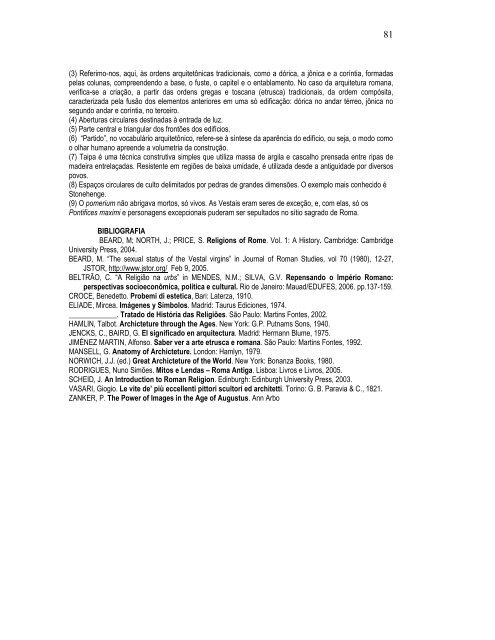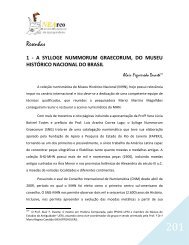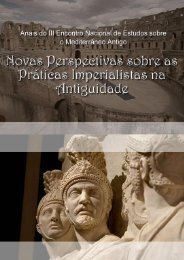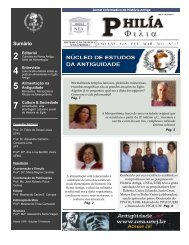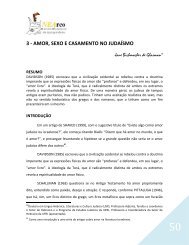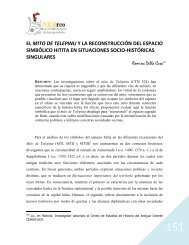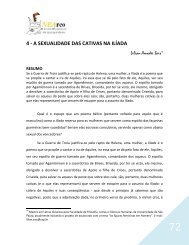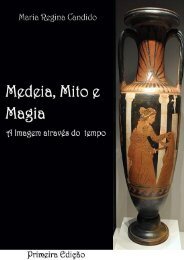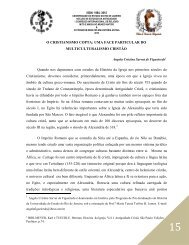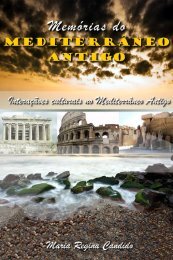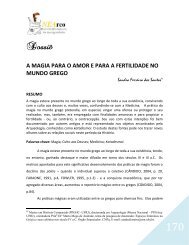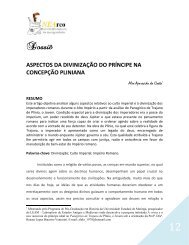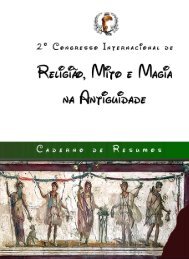Roma e as sociedades - Núcleo de Estudos da Antiguidade - UERJ
Roma e as sociedades - Núcleo de Estudos da Antiguidade - UERJ
Roma e as sociedades - Núcleo de Estudos da Antiguidade - UERJ
Create successful ePaper yourself
Turn your PDF publications into a flip-book with our unique Google optimized e-Paper software.
(3) Referimo-nos, aqui, às or<strong>de</strong>ns arquitetônic<strong>as</strong> tradicionais, como a dórica, a jônica e a coríntia, formad<strong>as</strong><br />
pel<strong>as</strong> colun<strong>as</strong>, compreen<strong>de</strong>ndo a b<strong>as</strong>e, o fuste, o capitel e o entablamento. No c<strong>as</strong>o <strong>da</strong> arquitetura romana,<br />
verifica-se a criação, a partir d<strong>as</strong> or<strong>de</strong>ns greg<strong>as</strong> e toscana (etrusca) tradicionais, <strong>da</strong> or<strong>de</strong>m compósita,<br />
caracteriza<strong>da</strong> pela fusão dos elementos anteriores em uma só edificação: dórica no an<strong>da</strong>r térreo, jônica no<br />
segundo an<strong>da</strong>r e coríntia, no terceiro.<br />
(4) Abertur<strong>as</strong> circulares <strong>de</strong>stinad<strong>as</strong> à entra<strong>da</strong> <strong>de</strong> luz.<br />
(5) Parte central e triangular dos frontões dos edifícios.<br />
(6) “Partido”, no vocabulário arquitetônico, refere-se à síntese <strong>da</strong> aparência do edifício, ou seja, o modo como<br />
o olhar humano apreen<strong>de</strong> a volumetria <strong>da</strong> construção.<br />
(7) Taipa é uma técnica construtiva simples que utiliza m<strong>as</strong>sa <strong>de</strong> argila e c<strong>as</strong>calho prensa<strong>da</strong> entre rip<strong>as</strong> <strong>de</strong><br />
ma<strong>de</strong>ira entrelaçad<strong>as</strong>. Resistente em regiões <strong>de</strong> baixa umi<strong>da</strong><strong>de</strong>, é utiliza<strong>da</strong> <strong>de</strong>s<strong>de</strong> a antigui<strong>da</strong><strong>de</strong> por diversos<br />
povos.<br />
(8) Espaços circulares <strong>de</strong> culto <strong>de</strong>limitados por pedr<strong>as</strong> <strong>de</strong> gran<strong>de</strong>s dimensões. O exemplo mais conhecido é<br />
Stonehenge.<br />
(9) O pomerium não abrigava mortos, só vivos. As Vestais eram seres <strong>de</strong> exceção, e, com el<strong>as</strong>, só os<br />
Pontifices maximi e personagens excepcionais pu<strong>de</strong>ram ser sepultados no sítio sagrado <strong>de</strong> <strong>Roma</strong>.<br />
BIBLIOGRAFIA<br />
BEARD, M; NORTH, J.; PRICE, S. Religions of Rome. Vol. 1: A History. Cambridge: Cambridge<br />
University Press, 2004.<br />
BEARD, M. “The sexual status of the Vestal virgins” in Journal of <strong>Roma</strong>n Studies, vol 70 (1980), 12-27,<br />
JSTOR, http://www.jstor.org/ Feb 9, 2005.<br />
BELTRÃO, C. “A Religião na urbs” in MENDES, N.M.; SILVA, G.V. Repensando o Império <strong>Roma</strong>no:<br />
perspectiv<strong>as</strong> socioeconômica, política e cultural. Rio <strong>de</strong> Janeiro: Mauad/EDUFES, 2006. pp.137-159.<br />
CROCE, Bene<strong>de</strong>tto. Probemi di estetica, Bari: Laterza, 1910.<br />
ELIADE, Mircea. Imágenes y Símbolos. Madrid: Taurus Ediciones, 1974.<br />
_____________. Tratado <strong>de</strong> História d<strong>as</strong> Religiões. São Paulo: Martins Fontes, 2002.<br />
HAMLIN, Talbot. Archicteture through the Ages. New York: G.P. Putnams Sons, 1940.<br />
JENCKS, C., BAIRD, G. El significado en arquitectura. Madrid: Hermann Blume, 1975.<br />
JIMÉNEZ MARTIN, Alfonso. Saber ver a arte etrusca e romana. São Paulo: Martins Fontes, 1992.<br />
MANSELL, G. Anatomy of Archicteture. London: Hamlyn, 1979.<br />
NORWICH, J.J. (ed.) Great Archicteture of the World. New York: Bonanza Books, 1980.<br />
RODRIGUES, Nuno Simões. Mitos e Lend<strong>as</strong> – <strong>Roma</strong> Antiga. Lisboa: Livros e Livros, 2005.<br />
SCHEID, J. An Introduction to <strong>Roma</strong>n Religion. Edinburgh: Edinburgh University Press, 2003.<br />
VASARI, Giogio. Le vite <strong>de</strong>’ più eccellenti pittori scultori ed architetti. Torino: G. B. Paravia & C., 1821.<br />
ZANKER, P. The Power of Images in the Age of Augustus. Ann Arbo<br />
81


